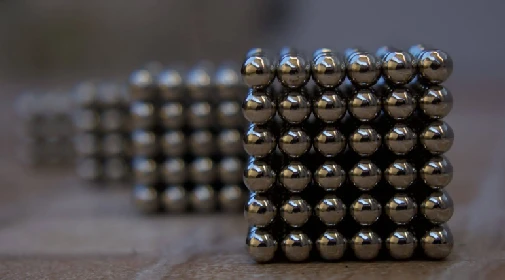
Can You Take Magnets On A Plane? – Small or weak magnets can be taken onto an airplane without affecting it in any way. However, very strong magnets shouldn’t be taken onto an airplane because they can cause a serious disaster with either the plane or other passengers’ cargo.
Your average magnet is fine to take with you. If you feel like you have a particularly strong magnet, read on as there are a number of things to consider. We will give you the thresholds, formulas and ways to measure your magnet’s strength and discuss best practices for transportation as well.
If you follow these best practices, you can bring magnets in your carry-on or checked bags.
Whether you have strong magnets to fly with or not, have a look at this air shipment milligaus meter, and read on!
Can you take fridge or souvenir magnets on a plane?
Yes, you can take refrigerator or souvenir magnets on a plane. Typically they aren’t strong enough to interfere with the plane’s compass or instrumentation or passengers’ hardware or software.
However, some magnets can interfere with navigational equipment on planes. It’s recommended that only certified personnel place strong magnets on aircraft if they exceed certain thresholds. This calculation is below.
Refrigerator magnets and other types of fridge and souvenir type magnets won’t ever cause you any issues.
Are magnets allowed in carry-on luggage?
Yes, you can take regular fridge or souvenir magnets on a plane. Typically they aren’t strong enough to interfere with the plane’s compass.
However, some magnets can interfere with navigational equipment on planes. It is only recommended that certified personnel place magnets on aircraft if they exceed certain thresholds.
Refrigerator magnets and other types of fridge and souvenir type magnets won’t ever cause you any issues.
Can you take magnetic toys on a plane?
You don’t need to worry about bringing ordinary toys and gadgets that may have magnets in them on a plane. In general, the presence of a magnet shouldn’t stop you from bringing it with you. Typically magnetic toys are low enough in their strength they won’t impact the aircraft’s operation.
It’s a good question though. Magnetic materials are a part of the “Dangerous Goods International Manuals” that airlines need to comply with.
Yes, you can take regular fridge or souvenir magnets on a plane. However, some magnets can interfere with navigational equipment on planes. It is only recommended that certified personnel place magnets on aircraft if they exceed certain thresholds.
Can you bring strong magnets on a plane?
Are magnets allowed on airplanes? Both yes and no. They may adversely affect the aircraft’s navigational and operational equipment. Transporting magnets that meet the thresholds outlined below should only be done by persons with the appropriate training and certification as they can be classified as class 9 hazardous materials.
Due to the various means of navigation airliners use, like inertial navigation or GPS, an airliner won’t go off course because of magnets.
While there isn’t a high probability of interference with aircraft systems, really strong magnets carried unsafely can potentially affect other passengers’ belongings, like data on hard drives or other devices.

How do you transport strong magnets?
Strong magnets can be transported in two ways. If they are smaller they can go properly packaged in a cardboard box, but magnets of larger sizes must be crated. Magnetic arrays, assemblies, and large magnets will be packaged in wooden crates. Most of the time, LTL carriers are required for transport.
Magnetic fields or magnetic induction are measured in milligauss by an air shipment milligauss meter.
US Department of Transportation and the International Air Transport Association have set precise guidelines, measured in milligauss, for the transport of magnets by air.
If the field strength is measured by an air shipment milligauss meter and is greater than 5.25 milligauss at 15 ft away from the package, that magnet is too strong to ship. (FAA Title 49, Part 173.21 Forbidden materials and packages)
Between that measurement on the high end and 5.25 milligauss at 7 ft away, that may be shipped but needs to be labeled “magnetized material.” IATA (International Air Transport Association)
Again, your average refrigerator magnet or even a bunch of them don’t come close to this strength.
I like this air shipment milligaus meter by Trifield. With this case for storing or traveling with it.
Using a milligauss meter
The position of the magnets influences the reading from a milligauss meter. If you are shipping multiple magnets, flip them around so they sit side by side with the opposite poles touching each other and the field strength decreases to a negligible amount.
The opposite is true, if they have the poles in the same direction, the magnetic field can be up to twice their individual amount.
Using an ordinary compass
5 milligauss is all it takes to move an ordinary compass 2 degrees.
Here is a short video demonstrating those two methods for measuring magnetic field or magnetic pull before shipping or flying with a strong magnet. They also show a third method.
Use magnetic isolation
If you are flying with or shipping strong magnets please consider magnetic isolation, especially for a lot of magnets.
Steel-lined boxes are one-way magnets are often shipped to remain below the acceptable limits.
The magnet can also be surrounded by several layers of this flexible magnetic shielding with insulation between each layer.
A simple box lined with a steel sheet-metal shield is often the best solution for really strong magnets.
Related: Do Pills Have to be in Original Bottles When Flying?
Can you bring a magnetic chessboard on a plane?
The TSA will let you bring a magnetic chess set or chessboard with you on a plane. The magnets in chess boards are not strong enough to cause any issues with the plane or its navigational controls.
Related: How Strict Is Ryanair With Carry-On & Personal Item Size?
Can I bring neodymium magnets on a plane?
If you don’t know, neodymium (Nd) magnets have the highest magnetic field strength in the world. They are made of crystalline magnetic structure used in them is Nd2Fe14B – an alloy composed of neodymium, iron, and boron.
Are you allowed to bring neodymium magnets on a plane? Yes and no. Neodymium magnets can interfere with aircraft navigational equipment. From a moderate distance, most small magnets won’t affect these instruments in a significant way. See the magnetic induction thresholds from above to know whether your specific magnets are flight-worthy.
To be on the safe side, you should call and ask. Cargo staff can advise you on what’s feasible and how to pack them since just throwing them in your suitcase isn’t the best way to “find out” if they are or not.
An experience taking magnets on Air France
I read of a man’s recent experience where he flew from Germany to Paris, then on to Africa, using Air France with two heavy welding magnets.
He first called Air France and spoke to them for some time about heavy duty magnets for welding. They looked and called supervisors and after nearly an hour they came back and said that “There is nothing in the Air France documentation that describes household magnets being restricted. So they are currently allowed.”
While checking in online, he declared that he did not have any prohibited items with him.
Magnets weren’t on the list of prohibited items, he noted. During the trip, his carry-on luggage was thoroughly searched. He brought a lot of luggage. But everything was in order.
In his case, two magnets that can lift about one kilo each weren’t a problem on Air France.
In his suitcase, the magnets had been securely packed in the center so as not to move around too much.
I include that story because I always like to hear of other people’s experiences.

Do Airplanes Have Magnets?
Airplanes do have magnets. They are used in magnetic compasses, motors and generators, as well as in a few other places. The compass is a navigational instrument and is used in all kinds of planes, from Cessnas to Airbuses.
So, there are different types of magnets that serve many functions in airplanes and airports. Some of these are;
- Temporary magnets: these are magnets made of soft, deformable materials. Iron nails and paper clips are good examples. Their magnetism only lasts for a short period of time.
- Temporary magnets: these are magnets made of soft, deformable materials. Iron nails and paper clips are good examples. Their magnetism only lasts for a short period of time.
- Electromagnets: These magnets are often generated by electricity. They’re found primarily in MRI machines and metal detectors.
Other types of magnets include hook magnets and rubber magnets. You’re bound to find all of these magnets. They all perform the following tasks in the aircraft;
- They serve as an ice detector in the lubrication system.
- Generation of electricity.
- Wing movement.
- Compass generators/ alternators.
- Navigation.
- Relaying a series of instructions.
Bringing Magnets with you on a plane
Many planes have sensors that are very sensitive to electrical noise. Therefore, bringing magnets could cause a current flow. So if it’s necessary to carry magnets, here’s what you need to keep in mind;
- Strong magnets must be packed in sturdy boxes so that they don’t get caught on metal objects in the aircraft.
- The maximum field strength of magnetized material may be 0.00525 gausses when measured 15 feet from the surface of the crate.
That means you can take a magnet with you, but it can’t be too powerful. And to ensure 100% safety, you should pack it safely regardless if it is in your luggage, purse, or backpack.
Now, there are some magnets in common items that you can take with you on the plane. Below are some of the items you can take with you;
- Headphones
- Laptops
- Jewelry
- Smartphones
- Calculators
- DVD players
You can take these items on the plane without hesitation, as they don’t affect the stability of the aircraft in any way.

Why are magnets not allowed in flight?
We have talked about the kinds of magnets that can be taken on a plane. Some magnets aren’t allowed on planes as well.
Due to the ability to interfere with navigation and electronic equipment, magnets strong enough to generate 5.25 milligauss at 15 feet aren’t allowed on flights in the US.
It is also not possible to ship dangerous magnets by air, especially industrial magnets, magnetic assemblies, and strong rare earth magnets. A lot of commercial airlines won’t accept and ship heavy strong magnets.
It is best to transport them by train or truck instead.
Related: Can I bring my Xbox or PS4 game console on a plane?
Packing magnets well for shipping or flying with them
It’s always important to take care to package magnets well. They should be boxed or sealed completely to avoid accidents. If you are flying with them, they should be well padded and put in the middle of your luggage to allow as much space between your bags and the other bags it will be around.
If the magnet has a high magnetic field strength, it should be packaged with extra padding or in steel-lined boxes. This will weigh more, and it takes more time and materials to pack but needs to be done to transport them safely.
Can you wear magnetic lashes through the airport?
You can wear magnetic lashes through the airport. They are safe and do not cause any issues as long as they do not get into your eyes. Most metal detectors can’t detect fine magnetic fragments because of their sensitivity.
Will magnetic lashes go off in a metal detector?
No, they won’t set off any metal detectors. The magnets are too small to set off metal detectors. Other kinds of magnets will likely set off the airport’s metal detectors.
Will metal detectors find magnets?
Magnets and magnetic metals can generally be detected by all metal detectors. In general, metal detectors can detect larger magnets, but sensitivity limits their ability to detect fine magnetic fragments.
Takeaways – Can You Take Magnets On A Plane?
Can I carry magnets in flight? As far as the TSA and flying in the US is concerned you should be fine flying with almost any consumer product that is a magnet or has a magnet in it.
If you are looking to transport a strong magnet, get the magnetic strength of the magnet measured and follow best practices outlined in this article and you will be fine.
If you are transporting the strongest of magnets, you might need to ship them via a ground carrier.
I hope you have found this article helpful.
